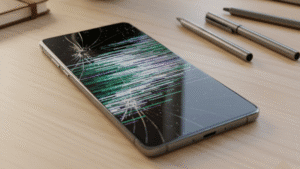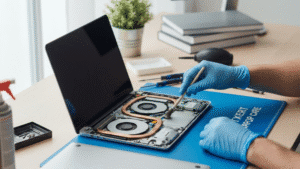There’s nothing more frustrating than opening your MacBook, only to find the trackpad behaving erratically or completely unresponsive. For many users, this seemingly random issue can bring your productivity to a halt, whether you’re responding to emails, editing documents, or designing a presentation.
Understanding the cause of these problems is essential to avoiding unnecessary repairs or downtime. In some cases, a simple adjustment may suffice, but often professional assistance is the safest route. If you’ve been struggling with a problematic trackpad, it’s time to explore both practical solutions and expert advice. With the right approach, you can restore smooth functionality and ensure long-term performance, all while keeping MacBook repair needs minimal.
Why the Trackpad Matters
The trackpad is not just a replacement for a mouse; it is the primary interface for interacting with your MacBook. From everyday scrolling to advanced gestures, a well-functioning trackpad is critical for productivity and efficiency.
Gestures and Productivity
Modern MacBooks rely heavily on multi-finger gestures for seamless navigation. Swiping between applications, accessing Mission Control, or zooming in on documents—all of these require a responsive trackpad. Even a slight lag can disrupt workflow and lead to unnecessary frustration.
Advanced Hardware Considerations
While all MacBooks feature high-quality trackpads, models like the macbook pro include Force Touch technology and pressure-sensitive input. This advanced hardware enhances productivity but also increases the sensitivity to potential issues. A minor misalignment or hardware wear can translate into noticeable performance problems.
The Hidden Culprits Behind Trackpad Problems
Trackpad malfunctions often appear without warning. Understanding the unseen causes can save both time and money, and prevent small issues from escalating into major repairs.
Software Glitches
Outdated macOS versions or software conflicts are surprisingly common culprits. Applications running in the background can interfere with trackpad gestures, causing unexpected lag, freezing, or erratic cursor movement. Simple software updates or removing conflicting apps can sometimes restore functionality without further intervention.
Battery Issues
A less obvious cause is battery swelling. Over time, lithium-ion batteries can expand, exerting pressure on the trackpad from below. This can result in sticky clicks, unresponsive areas, or a wobbly trackpad. Ignoring this issue may not only affect trackpad performance but can also pose safety risks.
Hardware Wear and Tear
Dust, crumbs, or minor liquid exposure can infiltrate the trackpad assembly, while flex cables may wear out over years of use. Such issues can lead to inconsistent behaviour or complete failure, often requiring professional servicing to correct.
Settings and Calibration
Occasionally, trackpad problems stem from misconfigured settings. Adjusting tracking speed, disabling Force Touch, or recalibrating gestures can resolve many apparent malfunctions. However, these fixes only work if the underlying hardware or software is intact.
Practical Fixes You Can Try at Home
Before resorting to professional repair, several practical steps may restore your MacBook trackpad functionality.
Reset Methods
Resetting the PRAM/NVRAM and the SMC can solve many minor trackpad issues. These resets refresh the system’s memory and controller functions, addressing software-level conflicts that might impede normal operation.
System Preferences Tweaks
Accessing the Trackpad settings in System Preferences allows you to adjust click sensitivity, tracking speed, and gesture options. Disabling features that conflict with your workflow may immediately improve responsiveness.
Cleaning and Basic Care
Use a soft, lint-free cloth to gently clean the trackpad surface. Avoid using abrasive materials or attempting DIY internal cleaning unless experienced. Proper maintenance prevents dust accumulation, which is a common contributor to sticky or unresponsive trackpads.
When the Issue Runs Deeper
Some trackpad problems are not solvable at home and indicate a deeper hardware or system-level issue. Persistent malfunctions may require professional attention, particularly if there’s a risk of losing important data.
Identifying Serious Problems
Signs that your trackpad has a deeper issue include sporadic responsiveness, unregistered clicks, or inconsistent cursor movement despite software tweaks. These symptoms often point to internal component wear, pressure from battery swelling, or damage to the trackpad assembly.
Risks to Your Files
Severe trackpad issues can sometimes coincide with system instability. In cases where the internal components are compromised, the risk of data corruption rises. If files are at stake, consulting a data recovery specialist ensures your important information remains safe while the device is repaired.
The Value of Expert Support
Professional assistance is invaluable when home fixes fail or deeper hardware issues arise. While minor software tweaks can solve some problems, more complex malfunctions require expertise and specialised tools.
When to Seek Assistance
If the trackpad remains unresponsive after resets and calibration, or if you suspect internal damage, it is time to consult a professional. Attempting DIY repairs in such situations may void warranties or cause further damage.
Trusted Local Support
In South Australia, MacBook experts in Adelaide offer reliable diagnostic and repair services. Professional technicians can safely replace damaged components, resolve battery-related issues, and restore your device to full functionality. By seeking expert support, you can ensure efficient repairs with minimal risk to your MacBook..
Preventing Trackpad Problems
Preventive care can extend your trackpad’s life and avoid frustrating issues.
Regular Maintenance
Keep your MacBook updated with the latest macOS versions, monitor battery health, and avoid prolonged exposure to heat or direct sunlight. Regular updates help maintain software compatibility and prevent glitches.
Smarter Usage Habits
Avoid using the MacBook on uneven surfaces or placing heavy objects on the trackpad area. Use protective accessories that do not interfere with its function, and practice gentle handling to reduce wear and tear over time.
Model-Specific Considerations
Different MacBook models can exhibit unique trackpad behaviour and challenges.
MacBook Air Considerations
The macbook air features a thin design, making its trackpad slightly more sensitive to flex and minor pressure. Users may notice issues more easily with older models or if the device has been exposed to slight physical stress.
MacBook Pro Differences
With the MacBook Pro, advanced gestures and Force Touch add complexity. While this enhances user experience, it also means that hardware or software issues may present in less obvious ways but significantly affect productivity.
FAQs
Q1. Why does my MacBook trackpad stop clicking suddenly?
- Sudden failure is often due to software glitches, battery pressure, or accumulated dust under the trackpad.
Q2. Can a frozen trackpad be fixed at home?
- Minor freezes can often be solved with system resets or adjusting settings, but persistent issues may require professional help.
Q3. How do I tell if it’s hardware or software related?
- Software issues are usually intermittent and may respond to updates or resets, whereas hardware issues persist despite tweaks.
Q4. Will fixing the trackpad risk my files?
- DIY hardware fixes may inadvertently affect system stability. Professional data recovery services protect your files during repairs.
Q5. Should I fix or replace an older model?
- Evaluate costs, battery health, and performance needs for both MacBook Air and MacBook Pro before deciding.
Conclusion
Trackpad issues are common, but they need not derail your workflow. By understanding the hidden culprits—from software glitches to hardware wear—and taking appropriate action, you can restore smooth operation and prevent future problems. For deeper issues or professional support, consulting an experienced technician ensures a reliable solution. For high-quality repairs and guidance, trust Digimob to keep your MacBook performing at its best.



